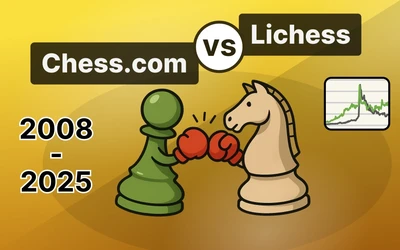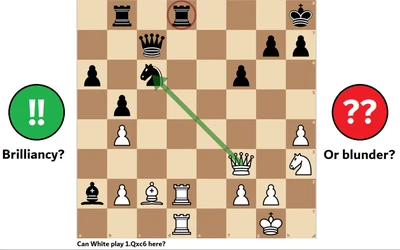
The Jobava London System: Play it, Counter it, Master it!
Do you want an aggressive, easy-to-learn system that can throw your opponents off balance? Or perhaps you're facing this "new" beast online and need to know how to tame it?The Jobava London is a simple and powerful opening that’s become really popular in recent years especially online. It’s great for players who don’t want to memorize a lot of theory. The ideas are straightforward, and it leads to sharp, creative positions without needing deep preparation.
Black players often don’t have a clear plan against it. Whether you’re a beginner, a junior, or just someone who prefers understanding over memorizing, the Jobava London is definitely worth adding to your repertoire.
And if you're on the other side of the board? We'll also look at how to face it confidently with Black.
Some of the ideas featured in this blog were ones I first saw in Simon Williams’ excellent Jobava course. His work was part of the inspiration for this post, and I highly recommend checking it out.
Main ideas & Plans for White
1- I'm going to show you one of the key differences between the London System and the Jobava London: how much more active the queen's knight can be with Nb5.
This is one of the key ideas behind the Jobava London—it's almost what the entire system is about. What I always say I love most about the Jobava is how flexible the opening is. You can keep using this idea and combine it with others I’ll introduce throughout this blog.
2-(h4-h5): What's fun about the Jobava-London is that this idea is standard in lines where Black plays ...g6. Let's take a look at this example.
The kingside plan doesn’t end here. There are deeper ideas White can go for, which we’ll revisit in the section for Black.
3- Nf3-e5 and overall controlling the dark squares
In my opinion this is the trickiest idea for white even though it's the most obvious one .
The knight is often very strongly placed on the e5-square, from where it controls several key squares. If Black ever tries to exchange it with something like ...Nbd7 followed by ...Nxe5, White will usually recapture with the bishop—if Black has played ...g6 and ...Bg7—or with a pawn if Black hasn’t played ...g6. Why? Well, if the bishop has moved to g7, White often aims to exchange it off, so placing the bishop on e5 makes that trade more likely. On the other hand, if a pawn recaptures on e5, it can become a strong attacking unit.
Countering the Jobava London as Black: Your Defensive & Counterattacking Arsenal
1- My favorite part of this study/blog
This one is for Black players who usually go for ...g6 setups—like myself. (White players, pay attention! These two examples highlight not only Black’s ideas but yours as well.)
I’m going to recommend our two beloved ideas: ...c5 and ...e5. As King’s Indian players, we’re used to kingside attacks, we’re not really afraid of them.
So what if white push h6 instead? If you're just a little bit patient.....
2- Against Nf3–e5
You’ve got several options here, but I’m going to recommend two specific lines:
1 – The simpler line:
This one focuses on keeping things under control and especially on taming the Nb5 idea. It’s easier to play and great if you want to avoid too much theory while still staying solid.
2 – The more solid and slightly advanced line:
This is more of a mainline approach. It’s something players will often be prepared for, but it’s also more reliable in the long run. The idea here is to prevent Ne5 from happening in the first place, which removes a big part of White’s typical Jobava pressure.
Example Games
- h4-h5 Craziness
- Beat Magnus with the Jobava
conclusion
- Against ...d5, ...Nf6, ...e6 (Classical setups): White aims for Nb5, then perhaps Nf3-Ne5.
- Against ...g6 (Fianchetto setups): White can launch a strong kingside attack with the classic h4–h5 push. And when that attack reaches its limit, the Nb5 and Ne5 ideas is always waiting to be used.
- Black's best counter Attack is c5 challenging the center across nearly all setups. In fianchetto positions, c5 may be supported by additional ideas such as Ng4 followed by e5.
Should I say the Jobava is aggressive? Absolutely.
Is it easy to learn? Yes, in the sense that its themes are clear and ideas are repeatable, but like any opening, it requires practice, analysis, and a willingness to keep learning and refining.
For Black players: don’t play on autopilot against the Jobava. Respect it, understand your own setup, and stay alert. Once you do, you can respond confidently and effectively.
Wishing you all exciting, creative, and enjoyable Jobava games!
You may also like
 ChessMonitor_Stats
ChessMonitor_StatsWhere do Grandmasters play Chess? - Lichess vs. Chess.com
This is the first large-scale analysis of Grandmaster activity across Chess.com and Lichess from 200… WFM Bullet_House
WFM Bullet_HouseThe Online Chess Paradox: How Your Digital Habits Impact Your OTB Game
We live in a digital age where online chess is more accessible than ever. The adrenaline rush of fas… GM Avetik_ChessMood
GM Avetik_ChessMood10 Things to Give Up to Enjoy Chess Fully
Discover how embracing a lighter mindset can help you enjoy chess again and achieve better results. WFM Bullet_House
WFM Bullet_HouseNo Plan in the Middlegame? Here's What Helps (and What Hurts)
The middlegame is often where chess games are won or lost, and yet, it's a stage that many players s… FM CheckRaiseMate
FM CheckRaiseMateWhat Good Opening Prep Really Looks Like
There are no prizes for memorizing random moves Mcie
Mcie